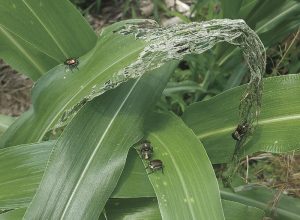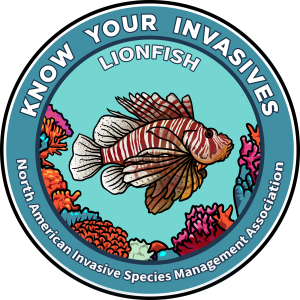Every month, new species are introduced to our lands and waters, new studies are published, and new methods of control are tested—with impacts varying across the map. It would be nearly impossible to stay on top of every piece of invasive species news.
However, the staff and board of the North American Invasive Species Management Association review headlines each month. This helps us stay on top of trends and further our mission to support, promote, and empower invasive species prevention and management in North America. We then share invasive species news most relevant for people who manage terrestrial and aquatic invasive species across the the United States, Canada and occasionally the world.
So, what happened this month?
- Canada is doing things right, with success stories including no AIS found in Saskatchewan’s waters, research on using an invasive crab’s shell for good, and the national government recognizing National Invasive Species Awareness Week.
- Invasive insect groups gear up for spring, from crop pest lists to a national phenology map of life-stage forecasts.
- Research shows invasive species affect the growth of walleye.
- These, plus much more! Read on:
Success Stories: Prevention, Eradication and Restoration
A Hamilton couple lit a prairie on fire to help wildflowers thrive
Ohio – Read on the Hamilton Journal News
The fire burns away most of the plants that aren’t supposed to be in a southwest Ohio prairie.
No Invasive Species in Provincial Waters in 2019
Saskatchewan – Read on The Outlook
Of 3,100 watercraft inspected, 217 watercraft were decontaminated and no aquatic invasive species were found.
How Long Does It Take To Pass An Invasive Plant Ordinance?
Arkansas – Read on the NAISMA Blog
The policy in Fayetteville, Arkansas, involved invasive species managers working with partners who care about the city’s unique biodiversity. Their simple approach took less than a year to go from idea to reality.
Further reading: Learn how National Invasive Species Awareness Week is raising awareness about how national and local policy—such as a local ordinance in one college town in the Ozarks—can protect North America’s most invaluable landscapes.
Prevention, Outreach and Education
Study Shows Boat Stewards Can Work
New York – Read on the Adirondack Daily Enterprise
Boaters who have ever had a prior encounter with a boat steward are also less likely to have AIS present on their watercraft.
Montana Fish, Wildlife, and Parks Tweaks Aquatic Invasive Species Rule
Montana – Read on the Missoulian
Canyon Ferry removed from its list of Bodies of Water Confirmed or Suspected for Aquatic Invasive Mussels.
Canada Recognizing National Invasive Species Awareness Week
Canada – Read on Business Insider
The Government of Canada recognizes that sustained effort and close collaboration with partners are key in tackling this issue.
Spot an invasive species while hiking? Report it through Washington Invasive Species Council’s mobile app
Washington – Read on the Seattle Times
Gov. Jay Inslee has proclaimed Feb. 24-28 Invasive Species Week in Washington, citing the potential $137 billion annual cost in damages to crops, forests, fish and other wildlife nationally as one reason why it’s important to manage the spread of invasive species.
New Research
Invasive species slow walleye growth, study says, meaning fewer survive winters
Minnesota – Read on the Star-Tribune
Both invaders reduce lake levels of zooplankton, an important food source for young walleye.
Invasive green crab could soon become biodegradable plastic

Nova Scotia – Read on CBC
Parks Canada partnering with McGill researcher who specializes in crustacean shells.
Don’t miss next month’s invasive species news. Sign up for the Early Detector, our free monthly newsletter for invasive species managers.
Detection, Management and Control

USA National Phenology Network Aids Management of Pest Insects With Life-Stage Forecast Maps
United States – Read on Entomology Today
“The most immediate benefit of the Pheno Forecast maps is in helping individuals who manage for these tree pests—tree care specialists, arborists, foresters, and natural resource managers—anticipate when they might want to take action to control the pest,” Crimmins says.
US Map of Biodiversity Importance now available in ArcGIS Living Atlas
United States – Read on ArcGIS blog
Where in your state would a new nature preserve help most to prevent species extinctions? It’s a hard question to answer, isn’t it?

Entomologist lists top invasive insects to watch in Midwest crops
Midwest – Read on Farm Talk Newspaper
Japanese beetle, soybean gall midge, and brown marmorated stink bug among list of pests.
Policy and Rulemaking
Sharp Cuts to Invasive Species Prevention
United States – Read or Listen on Virginia Public Radio
The Trump Administration has announced it’s cutting funding for prevention of invasive species entering the country. Scientists say the cuts will hurt many sectors of the economy, and even put national security at risk.
Environment Minister Dustin Duncan Presents Plan to Prevent Invasive Species
Saskatchewan – Read on Discover Weyburn
The plan emphasizes the need for collaboration and coordination among different groups to help prevent the introduction and spread of high-risk invasive species such as the Zebra or Quagga mussels that threaten lakes and rivers in western Canada.
Conversations
North America – Read or Listen on Science Friday
Conservation biologist David Lodge, who helped pioneer the eDNA method for tracking Asian carp, joins University of Michigan ecologist Karen Alofs to talk about how new species become invasive and how biologists decide what to prevent, what to protect, and, sometimes, what changes to accept.



